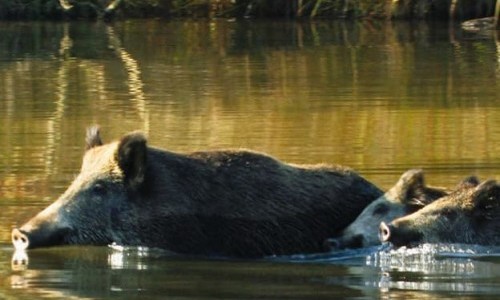River of Life (2012, Switzerland/France, Andreas Moser)
At four in the morning, when a mysterious mist lies over the landscape, when flocks of egrets fly from their roosting trees to their feeding grounds and you hear nothing but countless songbirds, the rare magic of such a landscape comes to light. Floodplains, the wetlands along rivers, are as full of life as almost no other landscape. The river constantly redesigns them, the floods wash away trees and pile up gravel banks. Rare birds breed here.
But it is not just the raw power of the water that makes a diverse floodplain landscape. The finer work is done by an animal landscape gardener: the beaver. It dams streams with its log dams and creates ponds. It fells trees and thus creates open spaces. A multitude of other animals and plants then benefit from these ponds and meadows - the river of life takes its course.
In Canada you can still find such pristine landscapes in endless expanses. This has been the case in Europe for thousands of years and would probably continue to work if humans, as designers with even more power, had not displaced the beaver and changed the landscapes to suit their own needs. Today, Europe's natural floodplains have been largely destroyed and have made way for fields, villages and towns. In order to protect the settlements, the rivers have been forced into a small space between dams and dammed to generate energy: this has now taken away any dynamism. In small-scale Switzerland in particular, people were extremely efficient at draining wetlands and straightening rivers until after the Second World War.
In a small area on the Rhine, in Alsace not far from the Swiss border, however, a small remnant of the original Rhine floodplains survived until the 1950s. The Petite Camargue Alsacienne lies around Europe's oldest fish farm, surrounded by the international airport, the motorway and industrial zones. It too would probably have disappeared long ago if it hadn't been for a handful of people who recognized the inestimable value of this landscape and fought with all their might to prevent its destruction. Thanks to this fight in the 1960s, the Petite Camargue Alsacienne is now a protected paradise for rare animals and plants. The protected area has been constantly expanded and attracts numerous nature lovers, including the biologist Felix Labhardt, who has been filming in the area for many years and has taken unique shots. Flocks of starlings gathering above the reeds in the evenings, waders hunting for fish and poking around in the mud for worms, the ballet of dragonflies laying their eggs, and wild boars swimming effortlessly through the water. He has also been able to capture rare birds such as the nightingale, lapwing, and kingfisher.
Information about the event
All current and additional information about the event can be found on the website of the organizer. Sudden changes will only be displayed on the website of the organizer.
- Time
- WWW
- Stream
- Links
- Source:srf.ch
